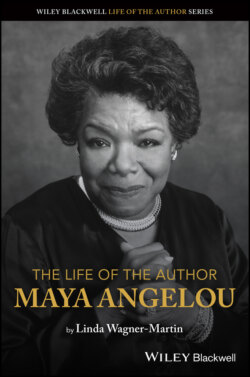The Life of the Author: Maya Angelou

Реклама. ООО «ЛитРес», ИНН: 7719571260.
Оглавление
Linda Wagner-Martin. The Life of the Author: Maya Angelou
THE LIFE OF THE AUTHOR
The Life of the Author
Contents
Guide
Pages
Acknowledgements
Illustrations
1 “There is Always an Engine, Maya” 1.1 The Birth of Marguerite Annie Johnson
1.2 The Train to Arkansas
Notes
2 St. Louis and Fear
Notes
3 Recovery in Arkansas
Notes
4 More Changes. 4.1 The Allure of California
4.2 A Dark Summer
Notes
5 Mothering
Notes
6 Performing
Notes
7 Writing
Notes
8 In Africa
Notes
9 Real-life Politics
Notes
10 Angelou as Autobiographer
Notes
11 “‘Testing the Ledge’: Screenplays and Directing”
Notes
12 Mrs. Paul Du Feu
Notes
13 Returning to the South
Notes
14 “On the Pulse of Morning” 14.1 The Inaugural Poem
14.2 The Trip Back to Ghana
Notes
15 The Prestige Years
16 The Last Years
Notes
Afterword
Notes for Maya Angelou, a Life. Chapter One: “There is Always an Engine, Maya”
Chapter Two: St. Louis and Fear
Chapter Three: Recovery in Arkansas
Chapter Four: More Changes
Chapter Five: Mothering
Chapter Six: Performing
Chapter Seven: Writing
Chapter Eight: In Africa
Chapter Nine: Real-life Politics
Chapter Ten: Angelou as Autobiographer
Chapter Eleven: “‘Testing the Ledge’: Screenplays and Directing”
Chapter Twelve: Mrs. Paul Du Feu
Chapter Thirteen: Returning to the South
Chapter Fourteen “On the Pulse of Morning”
Chapter Fifteen: The Prestige Years
Chapter Sixteen: The Last Years
Afterword
Bibliography. Maya Angelou Primary Sources
Essays and Other Non-Fiction
Poems
Spoken Word Albums
Short Stories
Children’s Books, Screenplays, Plays, Essays, Poems, Interviews, and Documentaries
Maya Angelou’s Prominent Roles (Film and Television)
Archives
Index (Angelou)
WILEY END USER LICENSE AGREEMENT
Отрывок из книги
This new series aims to transform literary biography from its status as a resource for facts and details to that of a dynamic, innovative aspect of teaching, criticism, and research. Outside universities lives of writers are by far the most popular genre of books about literature, but within them they are neglected as a focus for interpretation and as frameworks for advanced research. The Life of the Author will reverse this imbalance by exploring new questions on how and why our conception of the author frames our evaluation and understanding of their work.
New books in this series
.....
In the silent world of Sister Henderson’s store and household, Ritzie and Bailey were faced with an almost voiceless culture. For that reason alone, being an accepted part of the Colored Methodist Episcopalian congregation was exciting. They loved the hymns, and not only because Momma often led them. “Amazing Grace,” “Abide with Me,” “A Mighty Fortress Is Our God,” “Lead, Kindly Light,” “Our God, Our Help in Ages Past,” and a bevy of holiday anthems were the music the children could sing by rote. The tattered hymnals had only a few of these. Most parishioners knew the separate verses well, and if they didn’t, they hummed joyfully. No one cared how close the language was to what was written; nobody cared if an interval was a bit off. The spirit of Sunday bound all sounds into one glorious echo. Church became a magical place, suffused with harmony.
Like the path across the road from the store, which led to the African American school, the way to the church was often visible – especially when the children were eager for Sunday to come. Church was the only break in the dailiness that was life in Stamps: Bailey would begin school the following year but Ritzie had several years to be Annie’s helper in the store. She was a learner now. She was not yet a reader (because that was what she would learn at school) though she had found she could read some of the words on boxes and packages in the store. She could not make out what the King James Bible said, though she loved to listen to Uncle Willie reading from it. She was a good learner: she learned how to wash windows with vinegar water, and occasionally scrub dirty patches on the washboard. She learned how to hand the wrung-out clothes to Momma as she filled the wavering clothesline with the weekly wash. She was a hearty eater – always – though never quite so hearty as Bailey, Jr. She could scrape dishes into the slop bucket and some nights she could feed the pigs, but only if someone went with her. And she could regularly feed the chickens though their scurrying flapping was not her favorite part of the back yard. And she was a very good girl when she washed, remembering Annie’s joke that “first you wash as far as possible and then you wash possible.”
.....